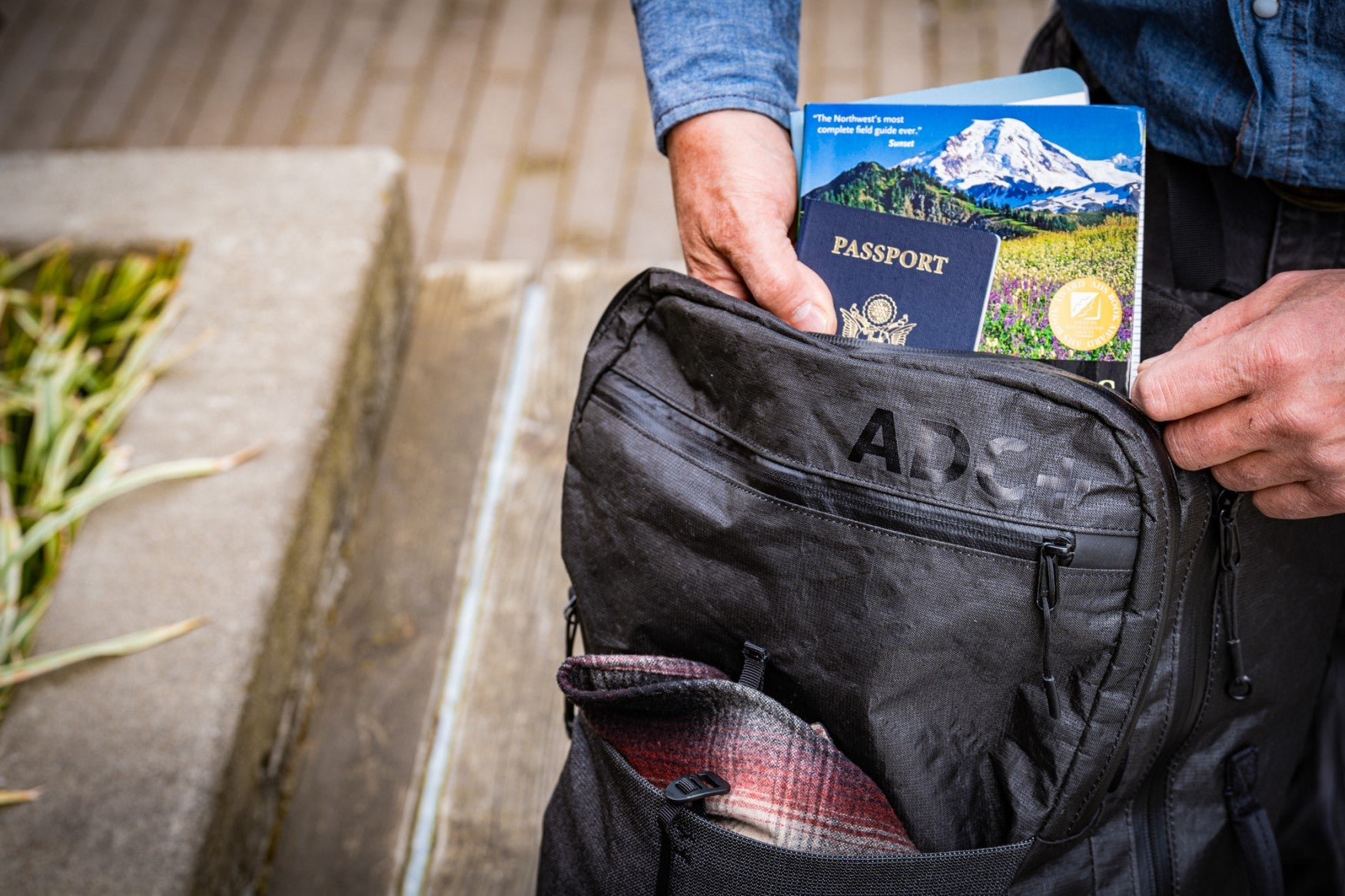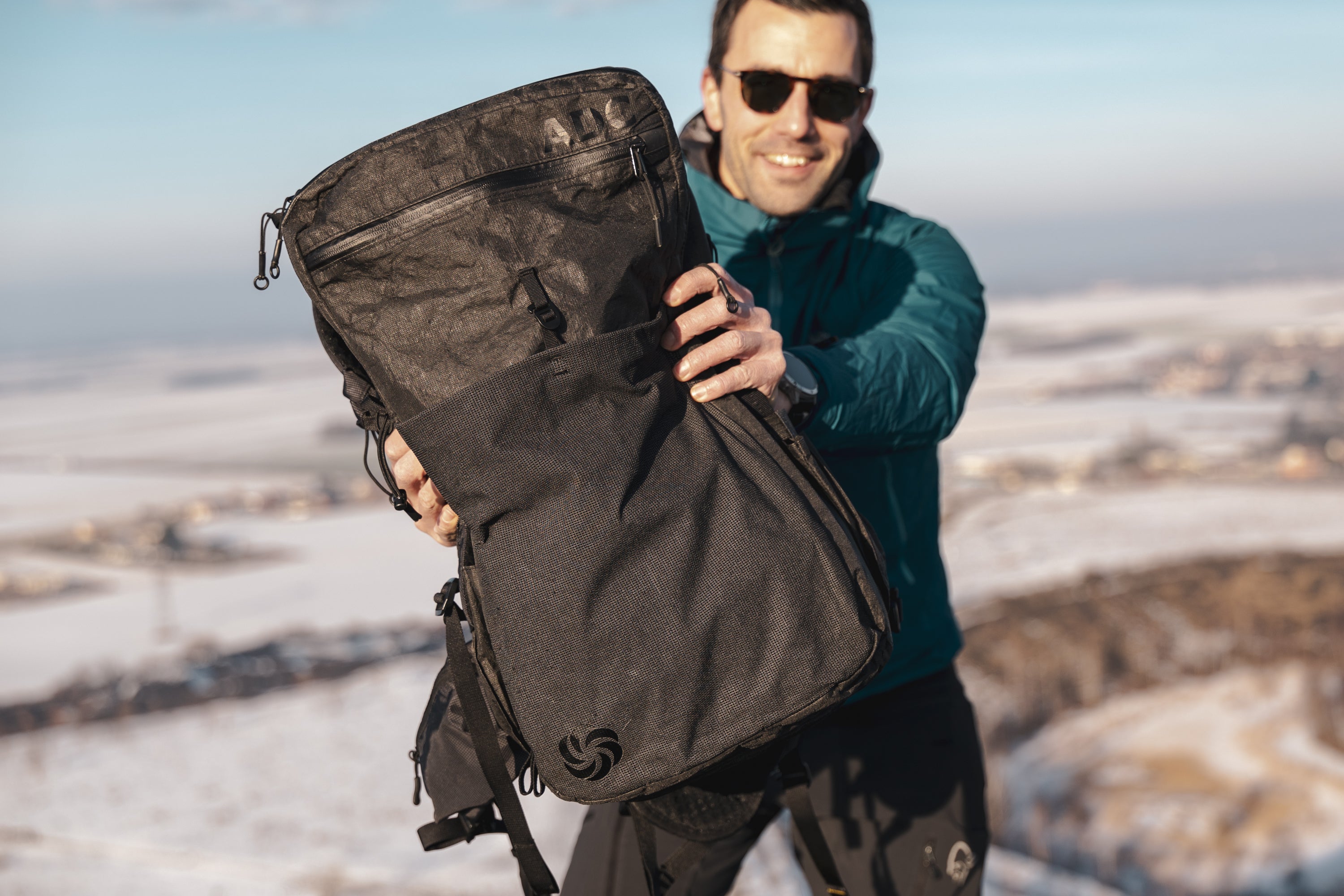This fall, I traveled with my Mom and my partner to Portugal to hike the Portuguese Camino. All three of us used the new All Day Carry backpacks for our multiple flights and the entire hike.
It was my fourth Camino de Santiago, my Mom’s second, and Karma’s first. This was a celebration for my Mom, who turned 70 this year. Portugal was on her bucket list, and she had a great time on the Camino Primativo, so we combined the two ideas.
Karma and I love using new gear, and my Mom was excited to have the same gear so we could teach her all the tricks.
So, we dove in and put the gear to the big test! Here’s the story of 5 flights, 494 miles of walking, and 47 nights.

From Airports to the Camino de Santiago
Karma and I like to go big when we travel internationally. Working seasonally allows us to travel longer, and I like to make the international flights worth it. My Mom is retired, so time was on our side.
We all tend to get the mindset of: well…we’re already traveling, so why not add an extra stop?
That was how we decided to make a pit stop in Denver on the way to Portugal from Seattle. It’s on the way, right?
Ok, you caught me. I made Melanzana appointments for the three of us back in January because they finally decided to use my favorite colors together (purple and teal). The 9-month appointment wait time was a tough pill to swallow, but I knew Seattle to Denver had cheap flights.
There, we quickly learned how easy it was to use the ADC backpacks through airports going from Seattle to Denver and then later from Denver to Dublin and Dublin to Lisbon.

Traversing Airports, Buses, Trains, and Taxis: Helpful Features
This is where the All Day Carry Backpack really shined. Throughout this trip, we traversed five different airports through security, customs, and immigration.
In the “Does your bag fit these dimensions” bins, the ADC 35 fit super easily without any shoving or tightening. I tested multiple of these on different airlines while I paced around during layovers in both the U.S. and Europe.
Between the packing cubes and pockets, I could easily segment important documents, my camera gear, lithium batteries, and toiletries (because, yes, you do need shampoo on a Camino!)
That made the scramble at security easier to navigate rather than the normal pack explosion of a top-loading backpack.
By the second flight, we tried removing the hip belt and tucking it inside. That was a game-changer! Without the hip belt, we weren’t accidentally bopping people in the aisle seats as we boarded.
As we got to our seats, the backpacks fit in the overhead compartment, both lying flat and on their sides.
We used the grocery-go-getter bags as our “personal items.” Those held the water and snacks we wanted access to throughout the flights. The zipper ensured that none of the items rolled out as we tucked them under the seats in front of us.
None of the flights became so full that we had to check our backpacks at the gate, but we did test stowing the shoulder straps just in case. The flight harness straps can tuck away easily.
At the end of the trip, we had to get from a small fishing town on the Atlantic Coast of Spain back to Lisbon. To do so, we took two buses, one train, and a taxi. We used the same system as the plane: stowed all the straps under the bus and used the grocery bag to take the essentials with us.
Our three bags easily fit into the trunks of smaller taxis and Ubers when needed.

The ADC Pack on the Portuguese Camino
You know how I mentioned that we like to go big when traveling internationally?
Well, we decided to start the Portuguese Camino from Lisbon instead of Porto, adding quite a few miles. Why? None of us had ever been to Portugal! If we started in Porto, we would only visit northern Portugal and only hike there for a little over a week before hiking into Spain.
We found the Portuguese people kind, warm, and helpful. With only some survival Portuguese, mixed with English, Spanish, and Danish at our language disposal between the three of us, we found ways to communicate.
The section between Lisbon and Porto went through many small towns and villages where we got an unexpected heat wave, followed a river, and saw large-scale tomato farms.
While the ADC Backpack thrived on planes, trains, and buses, we had an adjustment period when hiking.

Carrying Water
No Camino can compare to desert water carries in the U.S. However, you do still need to carry water hiking any Camino de Santiago.
Most of the time, you really only need 1-2 liters, depending on the gap between services and the weather. The most significant water gaps we encountered on the Portuguese Camino were 13-15 kilometers or 8-9.5 miles.
The ADC pack provided space for a water bladder and one tall side pocket for a water bottle that could reasonably hold a one-liter bottle. We opted for a three-liter water bladder and a 20-ounce bottle for shakes (yes, we brought a six-week supply of drink mixes…priorities).
This worked out well to distribute the weight, but I hadn’t used a water bladder in over a decade, and it took me a while to adjust. The water bladder compartment worked very well with one liter and got tricker with more.
The tall side water bottle holder worked great in an airport, but none of us could remove or put away the water bottle while hiking without help or taking the pack off.

Weight Distribution
Another part of that adjustment was really shifting our brains from a top-loading backpack like the Swift X/V to a side-loading pack. It took some thought and effort to get the weight distributed evenly while simultaneously keeping certain items more accessible.
I found that it worked best when I kept my sleep clothing and extra socks at the bottom, my albergue shower flip flops, towel, and shampoo in the middle, and topped it off with my shell and fleece. That way, during the day, I could access my go-to layers from the top.
I quickly learned how to make the contents of the packing cubes have a more even distribution in the morning before starting. If I hurried out of the albergue, I often had to do this right outside to make less noise for those still sleeping.

Hiking Pole Clips
I did not expect to carry my hiking poles for the majority of the Portuguese Camino. It was far flatter than the Camino Frances, del Norte, or the Primativo, and I just didn’t need them.
For that reason, if the Portuguese Camino is on your list, I recommend starting in Porto, not Lisbon. It’s still fairly flat after Porto until you reach Spain, but the amount of pavement decreases by Porto. There’s still more than there should be, but it’s nice to have more dirt paths.
Luckily, the attached hiking pole clips worked fantastically and stayed tight even on the Albergue floor while I dug through the pack day after day.

Unsung Gear Heroes on the Trip
First, our number one piece of gear on this Camino was our umbrella! Surprisingly, for both sun AND rain.
When we got to Lisbon in early September, the temperatures were a pleasant high 70s F, then quickly rocketed up into the 90-95 F realm. Remember how I said there was more pavement between Lisbon and Porto? That pavement heated up like crazy and radiated the heat back at us.
We adjusted to earlier mornings, and the umbrellas came out by about 11 a.m. to reduce our sun exposure. They stayed out all afternoon until we got to our albergue.
When the heat finally died down toward the end of September, the rain started. And when I say rain, I mean rain like the East Coast on the AT or Washington PCT rain. The drenching kind. The rain that you can see coming because it’s a literal sheet.
We walked through one category-one hurricane and a second one that was downgraded to a named storm upon landfall. Both included so much rain that we had it rained at least some of every day for two weeks straight.
Even the Europeans began to pick up cheap umbrellas in town to get some relief.
Second, the reusable grocery bags came in handy as personal items during transportation and helped us get food each evening. We kept them handy in the back mesh.
Eating plant-based in Portugal and Spain has gotten better each time I hike another Camino. However, it’s almost always easier to cook our own dinners at the albergues. We scoped out the facilities before getting groceries, which sometimes included a full kitchen and other times only a microwave and electric kettle.
This saved us a little money, preventing us from having to buy plastic grocery bags each night and preventing waste.

ADC Verdict: Would I Use It Again?
The short answer: YES. I’m going on a trip in January, and I’ll use it then. However, it won’t be a hiking trip, and I would hesitate before using it on another Camino mostly because of the water-carrying options.
I LOVED the ADC pack traveling on trains, planes, and buses, as well as moving from accommodation to accommodation.
As for Camino hiking, I think this pack would have worked great if I didn’t already use a more traditional ultralight, top-loading backpack like the Swift X/V.
However, while I did find it very easy to use at the albergues, I wanted my water system and weight distribution that I’m used to on U.S. trails during the hiking hours.

Conclusion
The summary: if you’re looking for a fantastic travel pack, the ADC shines. It’s functional, easy to use (once you adjust it properly), and it helps you stay super organized while traveling.
I’m stoked to use this pack again, traveling in January to meet up with friends and see how it works with my laptop and regular clothing. Based on the last 47 nights of use, I suspect it will work fantastically.
The nitty gritty: if I ever hike another Camino, I will probably take a Swift X/V because of those 47 days, 37 days were spent hiking. Therefore, based on that ratio, I would rather have a backpack fully geared toward hiking and less toward traveling.
On that same note, if you were traveling longer and your trip included a portion of the Camino (like the classic last 100km), then I would opt for the ADC. Basically, if your travel days exceed your hiking days, this is a great, functional pack.











Leave a comment
This site is protected by hCaptcha and the hCaptcha Privacy Policy and Terms of Service apply.